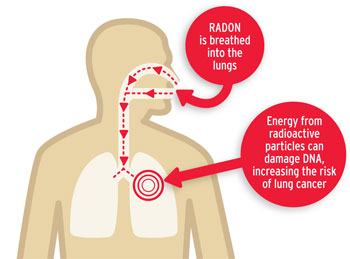In this article, we try to scientifically explain how radon gas can affect the lung and change its tissue.
Entry into the Respiratory System:
- Radon gas entry from the environment into the human respiratory system and it accumulates in lung cells.
Alpha Particle Emission:
- The release of alpha particles during the decay of radon gas and its impact on lung tissue. Examining the role of free electrons and radical molecules in the process of radon gas interaction with lung tissue.
Oxidative Stress Induction:
- The creation of oxidative stress as a result of alpha particle activity and its effect on cellular components of the lung.
Cellular and Tissue Changes:
- Cellular and tissue changes occurring as a response to radon gas exposure.

Solutions and Recommendations:
- You should find solutions and recommendations for reducing the adverse effects of radon gas on lung health, including proper ventilation, effective insulation, and accurate gas concentration measurement.
Specialized Research:
- Offering insights from specialized research on the mechanisms of radon gas impact, providing a deeper understanding of these effects on the human lung.
Summary and Conclusion: This article concludes that the mechanisms of radon gas impact on the lung are highly complex, and a precise understanding of these processes can aid in formulating effective strategies to protect respiratory health. The information derived from this research can assist health and safety organizations in developing improved policies and standards for reducing radon exposure.


